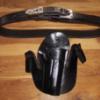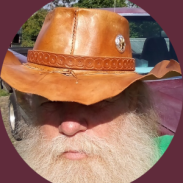-
Posts
562 -
Joined
-
Last visited
Profile Information
-
Gender
Male
-
Location
Las Vegas, NV
-
Interests
Handguns and Pizza!
LW Info
-
Leatherwork Specialty
Holsters
Recent Profile Visitors
6,404 profile views
wizard of tragacanth's Achievements

Leatherworker (3/4)
-
If it were my project, I may not clean the medallion at all but if I did, I would try a step-by-step solution. First would try dish soap and water with a toothbrush. That may be enough to keep the "heritage" look but not look so rough. If I wanted to go further, I would try to hit just the high-spots using toothpaste (a mild abrasive) on a layer of cotton cloth in my palm and using my other hand to work the medallion around without pressing too hard. This would highlight the letters and the edges of the medallion while leaving darker areas around the lettering and make US stand out. If that wasn't enough, then use buffing compound on a wheel. Nick
-

Source for 12-14 oz quality belt blanks
wizard of tragacanth replied to wizard of tragacanth's topic in Suppliers
I don't want to buy a side because I only want to make this one belt, for myself. I am about at the end of my leather "career" and do not want to stockpile any leather. I have a Tandy handy and could layer two of their blanks but I do not have a sewing machine. I said HO because if I am ordering sight-unseen. I want good leather and HO takes some guess-work out of the equation. Thanks guys. Nick -
Looking for quality 12 to 14 oz belt blanks e.g. Herman Oak or similar from U.S. supplier. Minimum length of 55", Nick
-

Want to get started on this craft
wizard of tragacanth replied to revilop's topic in Getting Started
Your top resources for learning leather craft are, this forum, YouTube and your local leather supplies store (such as Tandy). To give valid advice it is important to know what you want to make, other than a Batman mask. Will you be making other masks or wearable accessories like wrist cuffs or other costume stuff, like armor, etc? When I decided that I wanted to make holsters but was starting from zero, I assumed that I would need a swivel knife and a stitching pony. Fifteen or so years have passed without me owning either one. I don't do any tooling and a pony only makes sense if one is primarily stitching straight lines, as in a wallet and such. I bought a large 12x1`2 marble slab but later found a 6x6 was all I needed and much cheaper, lighter and more convenient. I bought a 12x12 Poundo board to go on top of the slab and later cut it down to four 6x6 pieces. Kits have many pros and cons. Often, the tools are lower quality. You've heard the buy once, cry once motto, right? You end up not using half of them and having to buy tools that were not included. A kit will get you started but I would recommend avoiding it. However, getting a kit may be the solution for some people. The old advice or buying what you need when you need it, is golden. There are several givens. Hopefully there is a leather shop near you where you can see and feel the leather. Leather choice is very important. You will need a way to cut the leather and most people have a generic utility knife that will work but if you are buying one, I recommend one that has multiple snap off blades, like an Olfa. If it starts getting dull, snap off a blade to get a new one. I use a new blade on every project now. It's nice to have a couple of sizes of knives, one for larger cuts and a smaller one for more maneuverability and cutting details. Some people use heavy duty scissors for some things. You need cutting tools. You will need a cutting surface. I use a Tandy Poundo Board. It's like a thick heavy "self-healing" black rubber. If you are making small, delicate work, there are the thin, green, cutting mats for sewing needs, sold at Walmart, Amazon and sewing shops. You will want a steel ruler for cutting, maybe a clear plastic ruler for other things, I have a special "centering" ruler that can be very useful. Also for measuring, spacing and marking, you need a pair of wing dividers e.g. Tandy Craftool $15... very useful. Now hear this... Harbor Freight has these same dividers in a set of 6 measuring tools for $10. OMG, what a deal. https://www.harborfreight.com/6-piece-technical-measuring-set-94447.html Need to know what you are creating to make any more suggestions for glue, thread, needles, hammer, etc. One of the kits that I saw on Amazon had maybe six type of needles. I have only used one type of needle since learning what I actually needed. This is an example of the waste in kits. Sometimes they include a rotary punch made of flimsy stamped steel. That was what I bought the first time. It was a joke. Lasted maybe three holes and the jaw went off-center. Paid around $15, totally useless. Must pay $50 to get decent ones. Expensive, but worth it. Still learning, I finally realized that my $50 rotary punch has a limited throat. I could punch to the center of a 1.5" belt but what if I want a hole in the middle of a 4" square? I could have bought, and did, both a Tandy mini and maxi punch set for a total of $30. Point is, you will buy some tools that you wind up losing money on. It is inevitable, but try to keep that to a minimum! I'm sure that I left out some important stuff but, I will leave that to the others of the forum! Nick -
Fascinating shop! Love the atmosphere... thanks for the tour.
-

New sheath
wizard of tragacanth replied to KillDevilBill's topic in Gun Holsters, Rifle Slings and Knife Sheathes
I think your friend's dad will treasure this sheath! -

Dummy gun
wizard of tragacanth replied to KillDevilBill's topic in Gun Holsters, Rifle Slings and Knife Sheathes
I have purchased two models from - branchworks3d - @ebay: S&W Bodyguard 2.0 and Sig P357. I am happy to report that they worked perfectly. -
Bruce, that's a great product recommendation. I just looked it up and it's on sale with 25% off but there is additional shipping cost. "Temperatures inside the cabinet can be set from approximately 135 degrees - great for finishing die-cast, other metals and wood - to approximately 100 to 105 degrees - ideal for plastic, resin and more." People have mentioned using heat up to 140° for holsters but I think that's too high. 110° is perfect. https://micromark.com/products/dr-dry-booth Nick
-

L H pancake for a H K 45
wizard of tragacanth replied to Hags's topic in Gun Holsters, Rifle Slings and Knife Sheathes
Nice work, great style! -
I used to use Tandy's Satin Sheen. Looking on their website now, I see Eco-Flo Satin Sheen. It appears to be the same product, but I am not certain. Probably is though. Not completely Matte but low-sheen. Instead, you could use Neutral shoe polish. With shoe polish, the customer can touch-up their holster easily. https://tandyleather.com/products/eco-flo-satin-shene?_pos=1&_sid=88e6f60ec&_ss=r
-

Never pass up an estate sale
wizard of tragacanth replied to AtomicLeather's topic in Leatherwork Conversation
Absolutely unbelievable. You lucky duck! -
I'm curious... what kind of "edge coat" was Nigel using? Nick









